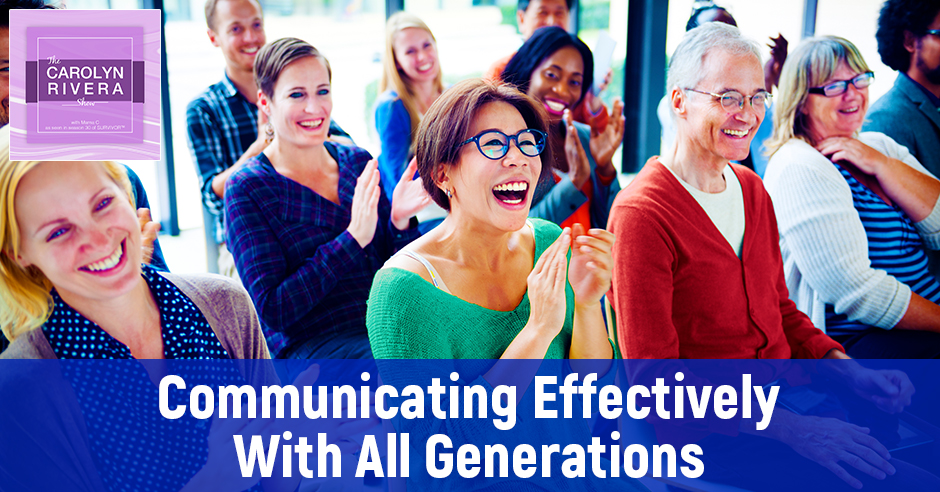
Communication is vital in our daily lives as we use it to convey our message. However, it may be hard when we all have different ways of expressing ourselves and doing things that work for us. If we want to get good at communicating, we have to make some adjustments. In this episode, Carolyn outlines the five generations that are living in the world today. Discover how these generations interact with the way they think, how they interpret things that may be different from us, and how all of our experiences affect the way we communicate. Also, learn the six tactics you can use to communicate effectively with people from all generations.
—
Listen to the podcast here:
Communicating Effectively With All Generations
When I think about how life happens, I always think about the people in my life that have shaped it, shaped who we are, shaped what we’ve done. It all starts with our mother. It’s great to be able to stop and thank your mom for all that she does for you. A mother’s job never ends and it doesn’t matter how young or how old your kids are. They’re still your kids and you want to do whatever you can to help them succeed. Thank you, mom, for all that you do each and every single day. If you’re out there, give your mom a hug.
In my line of work, I get to talk to a lot of different people and they come from all different backgrounds. One of the things that people always complain about is how other people don’t understand them. They get frustrated because they were told something or they tell someone something and the other person doesn’t understand what they’re talking about. Why do you think that happens? Because the other person maybe didn’t hear it or understand it in the exact same way. This is a universal problem. Communication is hard because we all have different ways of expressing ourselves. We all have different ways of doing things that work specifically for us.
We think that’s the best way. It may be the best way or it may not. There may be another way to do it that’s even better. The point is that communication is only as good as the people communicating. It’s only as good as the time and effort we put into each and every exchange. Sometimes we take the time because we know that the topic is a challenging one. Other times, we don’t see the topic as challenging because maybe we have the expertise and experience in that topic. When we communicate it to someone else, we may not break it down to what they need and there lies the issue. We communicate from our own perspective and it may not work with all the people that you’re trying to communicate with every day.
Another thing to consider is that in our world, there are five different generations. When you begin to think of it in that way, you can see where all the issues may arise from. With the five different generations, that highlights all the differences that we have. That’s not even taking into account any cultural differences. Maybe we’ve grown up in other countries or other parts of the world. Think about it this way. Has the world changed in the last 75 years? You’re going to say yes. We can all agree that the world has changed just a smidgen or just a teeny-tiny bit in the last 75 years. That means that depending on who you’re talking to, they grew up in different times. They grew up with different experiences. The world has changed and we must change our communication style as well. If we want to ever get good at communicating, we have to make some adjustments. We have to continue to think about how we communicate and to whom we’re communicating.
I’m going to go through the different generations and how all of their experiences affect the way we communicate. What they think of and how they may interpret things may be very different from us. There will be some key pieces of information that you will want to take note of because there are many differences out there. You’re going to begin to ask yourself, “How do I communicate? Do I fully understand where the other person is coming from? What is their perspective? Am I sure that I understand what I’m talking about enough to put it into terms that somebody else will understand?” The worst thing that you can do in communication is to assume that the other person understands what you’re talking about. You have to make sure that they do.
I’m going to review the ten things that will help you out when talking to people from all different generations. We can’t always bucket people neatly and nicely into a clean category. You’re going to come across people who may be considered Baby Boomers, but act and feel more like Gen X people. The key is to understand who you’re talking to. Find out what their needs are and tailor your message to meet those needs. If you don’t make those adjustments, those communication gaps and those issues with communication will continue to be part of your everyday life. You won’t be able to ensure that you limit those types of issues.
We’re going to begin to understand the differences between those five generations. All those generations that exist for each and every one of us. We will talk about how people grew up. What were the things that were happening in those specific times? We will talk about the percentages of those still in the workforce from all of those five generations. We will talk about attitudes, careers, products, communication strategies, the media and what some of their preferences are and why. These are the critical things to know and to understand. When you understand these things, it will help you eliminate those communication challenges that we all face every day.
The Maturists
We’ve got five generations that are with us. The first is Maturists. Some people call them Traditionalists or sometimes they’re even referred to as the Silent Generation. These people were born before 1945. They grew up in wartime. They were worried about how they were going to get food. They were rationing food. They were worried about having their family members go to war. Protecting their family was their single most important thing. The men worked and the women typically stayed home to raise the family. They had defined roles that they could work in like a nurse, maybe a telephone operator or things like that.

Why do you think they were called the Silent Generation? Because they didn’t like to talk about a lot of things. I’m sure that some of you have heard the phrase, “Speak when spoken to.” They grew up in that era as well. You didn’t offer up too much information to other people. As a child growing up, you never would participate in a conversation with an adult unless they asked you a question. Even if you were sitting in the same room, you had to be invited to that conversation or you just sat there quietly. You only participated when you were asked to do so. Nobody talked about any issues. Everything always seemed fine. If someone got divorced, they never spoke of it. It was totally ignored.
All of these things that happen in people’s lives that most of us are pretty open about, especially with social media, some people put their whole life history out there. These things back then were never discussed. They were ignored. Even in the household, with your family members, you never discussed things. That is how they got the name the Silent Generation. Parents didn’t even talk to their own kids about things that we would talk about now like sex, drugs and rock and roll for example. This is a much more formal generation. They prefer face-to-face communications. They’re a small percentage in the workforce now, only 3%. You still interact with some of those types of people. When you do, they typically worked from one company their entire life. They grew up where cars were the big product to purchase. Technology as we know it didn’t exist.
You need to understand where these people are coming from if you want to eliminate any of those communication issues. Their communication style, what they’re used to, how they grew up is probably extremely different than some of the other people that they’re interacting with. When you think about those people, remember they are about 3% in the workforce, but they grew up in different times. They grew up with different communication styles and strategies that they’re used to. Think about what would be the most effective for that type of person in this environment. It may look different than what you’re used to now.
The Baby Boomers
The next generation is the Baby Boomers. They are the people that were born between 1945 and 1960. They grew up in those swinging ‘60s. That’s how the youth identified that particular population. It was this youth-driven culture where they were focused on music and fashion. Pop culture started during that era. They grew up when the first person landed on the moon. They grew up with Woodstock, which was a three-day music festival for peace and music. The Baby Boomers were family oriented. They make up about 33% of the workforce now. They grew up where every household had a television. The big product during that timeframe was people wanted to get a television. Before it was all about the car, now it’s all about the television. This was the media outlet that everyone focused on.
The world has changed, and we must change our communication style as well. Share on XThey had a rotary telephone. I laugh because there are probably some of you out there that may not even know what a rotary phone is. A rotary phone is where you have to put your fingers on a specific hole and dial the number that way. I can’t even explain it. If you don’t know what a rotary phone is, you will have to look it up because those things are gone. They’re no longer available. Baby Boomers still prefer face-to-face communication. There are many things to think about when you’re thinking about communication. The first thing that you want to break down is how people grew up and what were their experiences so that you can understand where they’re coming from.
The Baby Boomers were outspoken. They grew up in the sexual revolution and the civil rights movement. They are referred to as the Me Generation because of all those different changes that they went through. It’s totally opposite of what we talked about with the Maturists. They had discos and nightclubs. There was a lot of focus on self-fulfillment. People began to be a little bit more health conscious. The first workout videos were started back then. You can see how generations have evolved and how things have changed. You can see how these experiences of how people grow up affect how they communicate.
Generation X
The next generation is called Generation X. This is from 1961 to 1980. This is the beginning of the digital age. People began to think about things in a more work-life balance mode. People became loyal to a specific profession rather than a company. The Baby Boomers may have stayed at the same company. For 25 years, they worked at one company. The Generation X people focused on a specific profession versus staying with a company and doing whatever they told you to do and changing jobs within that company. About 35% of the workforce now is made up of Gen Xers. The biggest product that the Gen X people work focused on was the personal computer. You have the car. You have the television. The next big thing that every household had was a personal computer.
Remember back in the day, those first email accounts, everyone had their AOL account. Some people still have them. That was before Google, Gmail and Hotmail. All of those things came after those AOL email accounts. Do you remember those chat rooms when they started? Some of you probably don’t remember those chat rooms out there. That’s when chat rooms first came about, which was an online community where people would go into a specific page and start talking to random people. This was when the latchkey kids grew up. Usually, their parents were working. They got keys to the house. They would come home after school. That’s why they were called the latchkey kids because both their parents were working and they came home to an empty house.

They grew up with less supervision. Divorce rates increased during this time. Title IX was passed, which provided girls with these athletic opportunities. This generation was dubbed the MTV Generation. Remember the first MTV music videos that were created. The MTV channel became the risqué place to watch. As you can see, there are huge changes within these three generations that we talked about so far. Could you imagine when people are growing up with these different experiences that their communication styles are going to be different? They are going to require different things. They are going to see things differently. Some things are more important than others, which may be different from generation to generation.
Generation Y
The next is Generation Y. These are also known as the Millennials, people born between 1981 and 1995. The Millennials grew up in this age of technology. They all grew up in their homes with these personal computers. They’re highly technical. They’re very comfortable with all kinds of technology. Most people, when they have a problem with any one of the technologies that we use, you go to your kids, you go to those Millennials and they know everything about the technology. They can tell you exactly how to do things, what to fix, what to press. They are very useful. Most Millennials had cell phones growing up as well. The product that households had during this timeframe was the cell phone. That’s when most people were trying to add cell phones to their household. The whole social media era began during this timeframe as well. Millennials are those digital entrepreneurs. Their mindset and how they work with companies is focused on that, being that progressive technologically sound person. Do you know what else came about during the Millennial age? Reality TV was introduced. I love reality TV. These are the things that we need to look at when we begin to see all those different generations.
What else happened during the Millennial age of growing up? They had to deal with the 9/11 terrorist attacks. They saw that entire thing unfold. They also grew up in this digital environment that we saw. They make up about 29% of the workforce now and by the year 2025, they’re going to make up about 75% of the workforce. Think about how they’ve grown up. Think about what their needs are and what they are comfortable with. They grew up when tablets were developed. They had this whole world of technology at their fingertips. Texting was made available as they began to get a little bit older. With all of these technological advancements, the Millennials have seen this whole Google Earth concept where you can see any part of the world. They have everything at their fingertips. They’re future focused. They’ve grown up doing lots of activities. They have the mindset that they can do anything. They’re open to all of the social issues. They’re concerned about the social issues. Those are the things that are important to them.
Generation Z
Generation Z, which is the last generation that we have. They’re born from 1995 and after. Interestingly enough, they’re most concerned with security and stability because they’ve seen job cuts. They’ve seen rising student loans. They’ve seen people graduate college and still can’t find jobs. That’s something that they’re concerned about. They realize that they have to stay up to date and relevant to the things that they want to focus on in order to stay relevant in the market and to be successful. They’re technoholics. They grew up in this world of technology where technology is everywhere. They’re growing up in this age of driverless cars, 3D printing, virtual reality, drones and all of those things. They have never grown up in a world without technology. If the internet goes down, I can imagine that they’ll lose their mind because they don’t know how to respond to that.
Experiences shape how people see the world and what's important to them. Share on XThe Gen Zs are not in the workforce yet. Some of them may be working part-time. Some of them may be having internships, but these people are social media addicts. They spend more time on their phones using social media than any other generation thus far. Think of what’s important to them. They need perfection. They grew up in this picture-perfect photo environment. Everything has to be Instagram ready. Think about these are the things that are important to them. They will download an app. If they take a picture and they don’t like the way their face looks, they will create a new one. They will take away this and they will put in that. It’s amazing. They’re creating their own little avatars because they make their pictures perfect.
They love music but no commercials. None of them is going to watch the commercials. They’re watching their stuff on Hulu and they’re watching things on Netflix. They fast forward through all the commercials. They get their music from Spotify, SoundCloud or whatever other options are out there. They have access to music and artists that haven’t even been signed to a deal yet. They can go on those platforms like AudioBox, SoundCloud or whatever the other ones are. That’s how their generation operates. They’re very focused also on getting data through crowdsourcing. They will look for reviews and ask perfect strangers for advice and information on topics that are important to them. They’re growing up in a world with unrest and violence, school shootings and random acts of violence. They’re more focused on maybe taking a stand and doing something about it.
All the generations have these unique things that shaped who they are and how they operate. It’s important to understand that and what those experiences that people have gone through are. Those experiences shaped how they see the world and what’s important to them. No matter where you fall in whatever generation, there are some things that are the same. For example, we all have a need for values, having a value structure: family, integrity, honesty, trustworthiness, whatever it is. We all want respect. It doesn’t matter what generation. We all want to trust our leaders and nobody likes change. No matter where you sit, no matter where you grew up, change feels uncomfortable. Everyone’s focused on loyalty. Everyone likes loyalty. Mostly, we all want to learn and receive feedback. We want to know how we’re doing. Those are some things to consider that every single generation wants. Those are the things that are important to all of us. You use those things in your communications as backdrops to make sure that you’re following through, you’re solving the needs and you’re communicating in a way that the other person will understand.
Six Tactics To Improve Communication
We broke down the different generations. We have that under our belts. There are six tactics to improve communications between all of these generations. What are the things to think about? The first is to use all forms of communication. I’m going to quickly tell you what these are and I will break them down for you. You’re going to understand the relevance of each tactic. Recognize and acknowledge that personal values are different between individuals. You have to personalize your communications approach to the person and don’t assume that people understand. What does that mean? The first is using all forms of communications and what I mean by that is face-to-face, email, text, social media.

You have to understand who you’re talking to and what the level of formality is needed with that specific person or topic. For example, if you’re meeting with somebody for lunch in the lobby. You text something that says, “Be downstairs at 1:00 for lunch.” You don’t need a formal email, regardless of the person you’re talking to, as long as the expectations are set ahead of time. If somebody doesn’t expect that you’re going to text them, they’re not going to look at it. They might not be looking for a text. You have to set the expectations that you will be using this form of communication ahead of time. That is critical. If you don’t, you will still be faced with some issues. I remember one time I told my daughter that I would pick her up if she needed me to. She was going out at night and she didn’t want to drive. I was expecting her to call me if she needs me. She texted me and I wasn’t expecting the text so I didn’t see the texts for over 30 minutes. She called me to find out if I was there. I said, “No, I’m home.” She said, “I asked you to pick me up.” I said, “I know I’ve been waiting for your phone call.” She texted me and I was not expecting the text. It was a clear miscommunication.
This ties directly to the next step, which is understanding the relevance of each communication tactic. For example, if you have something very important to tell your mother or your grandmother, you probably don’t want to do it over a text. It’s the same at work. You don’t want to do a performance review by simply sending an email. You would have a face-to-face conversation. It could be a video conference because you might not be at the same location, whatever the case is. It’s a more formal means of communication. You have to match the method of communication with the importance of the topic being discussed. You probably wouldn’t propose to somebody over text, although I have heard that people do break up via text. That’s probably not the best thing either. We all know there’s a more acceptable way to do those things. Use different tactics and match them up with the formality of the communication. Use the right vehicle at the right time.
Number three is to recognize and acknowledge that personal values differ. Not everyone is like you and you can’t only communicate with people the way you like to be communicated to. You have to think about the other person as well and what they’re used to. If you’re talking to a Maturist, they probably want a face-to-face. If you’re talking to a Millennial, they probably are comfortable doing it via email or over the phone. It doesn’t have to be face-to-face. You have to understand who you’re talking to. Even if you are the boss at work, you should be looking for ways to understand what motivates your people and try to flex your style to meet those needs. If you’re a Millennial managing a Baby Boomer, the Baby Boomer might be comfortable in a more formal environment. You as the boss should attempt as best as you can to provide them with what they need. It’s not all about you. When you communicate, the best communicators ensure that people understand them. They try to flex their style to meet the needs of the people that they’re talking to.
The next one is to listen. You can’t do all the talking. First of all, you will never learn anything new if you’re constantly talking. You learn so much by listening to other people. Hear their point of view. The key is to listen to what is said and how it’s said and make sure that those two things line up. You learn so much about a situation if you tie those things together. Match up what was said and how it was said because it will tell you how important it is to them. If you see the passion and if you hear it in their voice, you will get to know all those things.
You can't bucket people neatly in one place. Not everyone can fit into a specific category. Share on XThe next, number five is you truly want to perfect your communication skills. You’re going to have to learn how to personalize your communications. Change your approach and understand what people’s needs are. Understand what experiences they grew up with. What kinds of communication work for them? Figure it out because once you do, once you have the ability to change your style, believe me, you will feel so much better about all the communications that you have.
The last thing is don’t assume people understand. Many times, we walk away thinking that people understood exactly what we said, but we don’t validate it. If we don’t validate it, we have no idea what they understood and how they’re walking away and making sure that they’re comfortable with what we talked about. Your best bet is to understand, listen and figure it out. People like to communicate as you do. Not everybody, so you have to make those adjustments. You have to change and you have to ask if they understand and have them tell you right back in their own words.
We talked about all of the differences between people growing up in all different generations. Remember, not everyone was born in the same year that you were, therefore, they don’t operate the exact same way. They all grew up in a time when technology was on the rise. There are many things that are different and there are still many people who don’t even like technology. You can’t bucket people neatly in one place. Not everyone can fit into a specific category. Conversely, I’m sure that there are some Maturists who love technology. People are different. The key is to find out what is important to each individual.
We talked about those five generations. I walked you through how they grew up and what was happening in the timeframe and what was important to them. Once you begin to see the environment that people grew up in and you get a sense of what they went through, you begin to understand why things are important to them. You don’t have to agree with their values, but you do have to acknowledge that those values have existed. You do have to acknowledge the differences. We talked about those six tactics that you can use to improve your communications with people from all generations. No matter when they grew up, you have to use all forms of communication. You have to understand when to choose one over the other and with who. It’s all linked back to what’s important to the other person, not you. That’s the key difference.

Understand the relevance of each of those tactics. When do we use face-to-face? When do we use email? When can we use texts? It links back to the formality of the topic that you’re discussing. It links back to how complex a topic is. You have to begin to dissect the different messages that you’re trying to give to somebody else. Once you have that, then you can select the right methodology for communication. Recognize and acknowledge that personal values differ between people. My personal values may be different than yours. It may be important to me to have more face-to-face communications. If you know that and I work for you, it might be a good idea to make that happen. You can help me to understand why other types of communication vehicles are important to use and when to use them. You can use it as a teaching moment as well. The next one is to listen. We talked about that. You can’t learn things if you’re always talking. You have to listen to your people. You have to understand what motivates them. You have to understand what is important to them. Personalize your approach to meet their needs. Do not assume that they understand because some people don’t.
We’re going to have another great show for you. I do this show so that I can provide you with some value, things that you can take away and do differently that are going to help your lives. I’m always looking for topics that you’re interested in. Let me know what those are. My focus is on watching you succeed. Go to my website at CarolynJRivera.com. You can download these episodes. You can read previous episodes. You can send me a message on things that are important to you. Helping you achieve more than you ever thought possible is my specialty. I love talking to all of my audience. Remember, believe, commit, achieve. That’s the secret sauce you’re looking for.